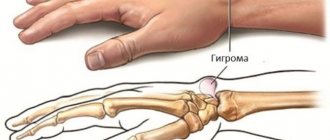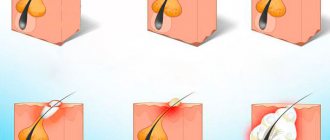( 1 ratings, average: 5.00 out of 5)
Home » Neoplasms
A ball on the neck under the skin in a child or adult can appear for various reasons. You need to be aware of the consequences and what to do. Don't rush to conclusions; perhaps there is nothing critical.
One thing is undeniable - you cannot leave it unattended, and if a problem is discovered, you should consult a doctor as soon as possible about what it is.
Types of neoplasms
Damage to the skin as a result of cell proliferation forms compactions of various types and sizes: from a pea to a walnut. Depending on the nature of the pathology of the formation, there are:
- benign;
- malignant;
- borderline (precancerous).
The formations cause physical and aesthetic discomfort to the child, but the main danger is their degeneration from a benign tumor to a malignant one. Only a doctor can determine the nature of the formation under the skin.
In this regard, we note that in addition to the otolaryngologist, solving problems of this kind may involve visiting other highly specialized specialists. Depending on the etiology and nature of the seals, treatment can be carried out by a dermatologist, surgeon, endocrinologist and oncologist. If necessary, the ENT doctor will refer the patient to the appropriate specialist.
Symptoms of paratonsillar abscess
Peritonsillar abscess usually develops on only one side. A patient who is already recovering from a sore throat or an exacerbation of chronic tonsillitis suddenly exhibits a complex of symptoms again:
A sore throat
Suddenly, one-sided pain appears when swallowing. The pain with a peritonsillar abscess is stronger than with a sore throat. It can radiate to the jaw area and ear.
Temperature
The temperature rises again to 39-40°C
More about the symptom
Swelling of the throat
Sometimes the swelling is so severe that not only swallowing is difficult, but also breathing through the mouth.
Benign formations
Relatively safe are:
- Lipoma (wen) is a formation consisting of adipose tissue covered with a fibrous membrane. It does not pose a threat to health if it is not inflamed, and is more of a cosmetic defect. Occurs due to disruption of lipolysis processes in adipose tissue.
- A furuncle is an inflammation of the hair follicle, which is a cavity in the skin filled with pus. The causative agent of this inflammation is staphylococcus. Untimely surgical treatment can lead to blood poisoning.
- Fibroma is a benign formation of connective tissue that forms at the site of an injury or scratch. Fibroma is completely painless and does not degenerate into malignant, but nevertheless, it must be kept under control.
- Inflamed lymph nodes are a constant companion of infectious diseases. As you recover, the seals decrease and return to normal.
- An enlarged thyroid gland is a consequence of impaired hormone production. The thyroid gland changes in size due to iodine deficiency or in case of genetic predisposition. The danger of nodular or diffuse goiter is that it can develop into a malignant tumor.
- Inflammation of the submandibular salivary glands can occur if it is blocked by a stone. As a result, saliva accumulates in the gland, causing pain and swelling. Infection may also be the cause of the increase.
What causes the problem
There are several common causes.
If some are not critical, then others require immediate contact with a specialist. Trouble may arise due to:
- ARI (acute respiratory disease) - ARI does not cause the appearance directly, it only promotes enlargement of the lymph nodes. The latter, both submandibular and cervical, being in an enlarged state, contribute to the occurrence of the problem. In this case, usually the ball on the neck forms on the side and back. There is nothing to worry about here, except for the very reason for its appearance, because enlarged lymph nodes are not normal (with the exception of a symptom of acute respiratory infections).
- wen - they also quite often lead to the appearance of such a compaction. This problem does not require intervention if it does not cause discomfort and does not increase. Sometimes, the wen resolves with age, but this does not always happen.
- boils - if the pus-filled follicle becomes inflamed, called a boil, it results in a sensitive lump. The cause may be too much cold, a weak immune system or poor hygiene. Severe pain and itching when pressed are signs of a boil.
- cysts - almost not accompanied by painful sensations. The seal is quite small and movable (when pressed). Moreover, when palpated, the formation may even disappear temporarily. But then it will definitely come back. Although the cyst is a benign formation, it is dangerous because the rolling ball contains either pus, lymph, or other fluid.
- folliculitis is an inflammatory process that occurs due to dirt or infection getting into the hair follicles. Poor immunity, excess weight and diabetes are the problems whose carriers are most at risk of folliculitis.
- Lipomas are a soft formation that develops without discomfort. So in most cases, removing the seal is not necessary. But if pain and itching are present, then it must be removed.
- malignant tumor - a sign of a malignant tumor is that the ball is hard. If, in addition, it hurts, does not go away for a long time and feels like a stone to the touch, this can be regarded as the first sign of a serious problem. During malignancy, the closest lymph nodes are affected first. If a person has a weakened immune system and everything is not fine with the thyroid gland, then he runs the risk of getting such a problem.
What formations hide danger?
The following types of neoplasms require urgent medical intervention:
- Atheroma is similar to a lipoma, but unlike it, it often becomes infected and turns red, and can also increase in size. It is this moment that poses a health hazard, since there is a danger of fistula formation and pus leaking into nearby tissues.
- A median cyst is a congenital benign round formation located on the front of the neck. Up to a certain point, it may not bother the child, but in 60% of cases it becomes inflamed with the formation of a fistula, causing pain and discomfort when swallowing. In addition, the cyst is prone to degeneration into cancer.
- Neurogenic tumors are formed at the ends of nerve trunks and represent a wide range of neoplasms. They can be safe, but malignant formations can also occur. Under no circumstances should they be left without the attention of a doctor.
- Lymphogranulomatosis (Hodgkin's lymphoma) is cancer of the lymph nodes. The first symptom of this cancer is expressed in enlarged lymph nodes, but they do not hurt and slowly enlarge.
The otolaryngologist makes conclusions about the safety of formations only after conducting a comprehensive examination. It is impossible to do this on your own.
Causes of paratonsillar abscess
As a rule, a paratonsillar abscess develops as a complication of tonsillitis or chronic tonsillitis. With tonsillitis, scars can form in the tonsils, preventing pus from leaving the lacunae (lacunae are natural narrow and highly branched cavities in the body of the tonsil). Pus that does not find a way out accumulates inside, from where it penetrates into the tissue surrounding the tonsil.
Diagnostic methods
As always, an appointment with an otolaryngologist begins with a visual examination. The doctor carefully palpates the formation on the neck and collects a detailed history based on complaints from the parents. To determine the nature of the lesion, blood flow and the exact size of the compaction, a number of instrumental and laboratory studies are carried out, including:
- Ultrasound, MRI and X-ray provide detail of soft tissues;
- biopsy followed by histological examination of the contents;
- laboratory blood tests.
As we mentioned earlier, consultation and additional examination may be required from specialists in other fields, for example in dentistry, endocrinology, oncology, dermatology. Based on the results of the examination, adequate treatment or dynamic observation will be prescribed.
What's behind the lump on your neck?
Already at the first consultation, an experienced doctor can determine the type of formation and select the appropriate treatment. In this case, the specialist performs palpation and asks the patient questions about concomitant or previous diseases. All this allows us to identify more accurate causes of swelling. Most often, a lymph node enlarged several times is hidden behind a lump on the neck. Let's figure out why the lymph nodes increase in size and how dangerous this condition is?
There are a large number of lymph nodes in our body. All of them act as a kind of filter through which lymph passes. They are located in small groups next to large blood vessels. In total, there are about 500 lymph nodes in the human body. Lymph passing through the lymph nodes is cleared of pathogenic microorganisms and other potentially dangerous agents. Here it is saturated with vitamins and immune cells, after which it enters the bloodstream and transfers all the resulting substances into the blood.
Typically, lymph nodes are not visible to the naked eye and can hardly be felt. However, as soon as pathogenic bacteria penetrate the body, active work begins inside the nodes. Here the production and maturation of lymphocytes and the destruction of bacteria occur. As a result of active work, the nodes increase in size and become noticeable under the skin. In some cases, the swelling may be painful to the touch.
Cervical lymph nodes perform the function of protecting the organs of the neck and tissues located in the face and head. It is to them that the lymph passing through these tissues flows. The normal size of lymph nodes can range from 5 to 10 mm. In fact, this is an approximate indicator, since each person's lymph nodes may be smaller or larger in size. Depending on which group of lymph nodes is inflamed, one can judge about a particular problem. For example, enlarged nodes under the jaw or on the sides of the neck may indicate problems with the nasopharynx, tonsils, and upper respiratory tract diseases. When there are problems with teeth, the nodes on the chin most often become inflamed. Lymph nodes on the back of the neck and back of the head react to any viral infections, including their enlargement, which may indicate rubella.
Treatment methods for peritonsillar abscess
A peritonsillar abscess cannot be cured on its own. Methods suitable for treating sore throat are not suitable here. If an abscess is left untreated, it may open spontaneously, but in this case there is a high probability that the pus will not completely come out and the inflammation will resume. Serious purulent complications are also possible: blood poisoning, phlegmon of the neck.
The treatment method for peritonsillar abscess is surgical.
Opening a paratonsillar abscess
The opening of a paratonsillar abscess is performed by an otolaryngologist in a surgical hospital. The operation is performed under local or intravenous anesthesia. The planned operation time is 1 hour. After the operation, you must be under medical supervision for 24 hours.
After opening the abscess, a course of antibiotics, gargling, and physical therapy are prescribed. The first time after surgery, food should be warm and soft (semi-liquid) so as not to irritate the healing wound.
Make an appointment Do not self-medicate. Contact our specialists who will correctly diagnose and prescribe treatment.
Rate how useful the material was
thank you for rating











